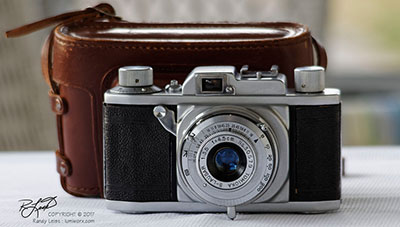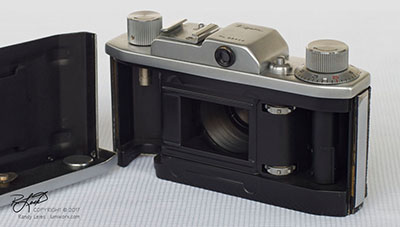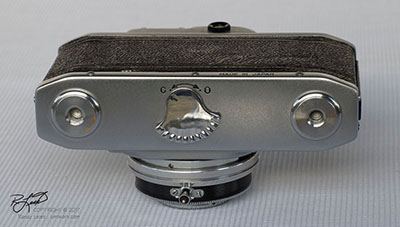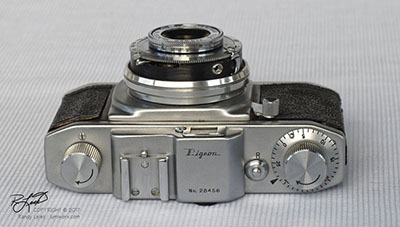Pigeon 35 & Related Models
Contents
(Scroll down or click on Links)
Inspiration
Pigeon 35 Based Cameras
Pigeon 35 Model I
Pigeon 35 Model P
Pigeon 35 Unknown Model (probably late I or early II)
Pigeon 35 Model II
Pigeon 35 Model IIA
Pigeon 35 Model IIB
Pigeon 35 Model III, IIIB & IIIC
Pigeon 35 Unknown Model (Model J-like)
Pigeon 35 Model J and JII
Pigeon 35 Model S
Lacon & Saga Models
Focusing, Shutters & Lenses
Body Castings
Cosmo 35, Micronta 35 & Rolex 35 Cameras
Inspiration
In October 1948, Takachiho Optical Industries Co., Ltd (to become Olympus Optical Co., Ltd. on 1 January 1949) launched the metal bodied Olympus 35, the first Japanese 35 mm viewfinder camera with fixed lens and leaf shutter (that is according to Olympus - Sugiyama agrees that it is the first post-War example of this type but also suggests that the bakelite bodied Super Olympic Model D of 1936, no relation, is “the first Japanese 35 mm camera with lens shutter” - regardless, there were already countless similar models to the Olympus 35 using 127 film). The Olympus had a f/3.5 4 cm Zuiko lens with 4 elements in 3 groups (i.e., probably Tessar design) and a Seikosha Rapid shutter with a full range of speeds to 1/500. The Olympus 35 II was a prototype that didn't make production and the Olympus 35 III was a minor update. The Olympus 35 IV was released in November 1949 and remained in production until 1953. This was fitted with a Copal shutter with a top speed of 1/200 and was undoubtedly the inspiration for the Pigeon 35, either directly, or as a result of other similar models which quickly appeared, such as the Tokyo Kogaku (later Topcon) Minion 35. The camera below is an example of the Olympus 35 IV (there were later IV a and IV b variants with upgraded shutters including a return to the Seikosha on the IV b):
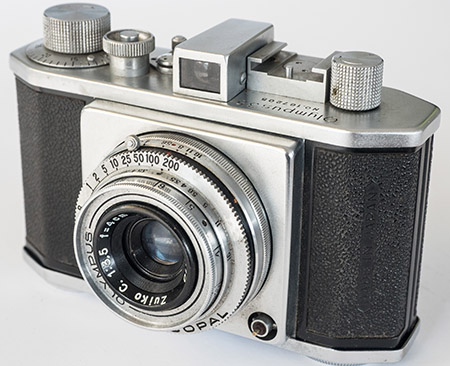
Note, the 35, 35 II and 35 III feature an external link to the shutter release somewhat like the Pigeon I and early Pigeon II models but on the Olympus cameras, this was hidden under a cover:
 (Detail from larger web image)
(Detail from larger web image)
Pigeon 35 Based Cameras
The Pigeon 35 wasn't just one camera or model, there were quite a few variants, all seemingly developed from the original, some as upgrades and some as budget versions. Similar Pigeon 35 based cameras were also sold as the Lacon by the Lacon Camera Co. and a late type of the Lacon was marketed as the Saga. Generally There seems to be a little uncertainty as to whether Lacon was a separate entity or Shinano's own marketing name but “Shinano Camera Company Ltd.” does appear on at least some Lacon branded versions.
Current commentators all note that examples of the 35 seems to be well made for the type and are quite heavy and solid feeling (just like the Olympus 35) with an impression of at least reasonable quality. Some examples of recent photographs taken with them can be found on the net and they all look decent at screen resolutions. However, whilst both the specs and operation were basic, pricing was a little surprising. Compared to the ¥14,800 to ¥15,000 for the Pigeonflex models, the budget Model J was a very reasonable ¥7,900, but the top range and only slightly more sophisticated Model III with Tri-Lausar lenses had an asking price of ¥15,500 (ads here). Meanwhile, the Olympus 35 varied between ¥10,600 and ¥15,500 depending on model and year. Its superior 4 element lens and sometimes superior shutter (Seikosha Rapid with 1/500 top speed on models I, III and IV b) make the Model III look quite over-priced which probably explains the price drop of the updated Model IIIC to ¥14,000.
Note that the more sophisticated, folding rangefinder types, Pigeon V and 5B, were derivatives of the Toyoca B35 made for Endō by Tougodo, not Shinano and are not covered here. However to put the Pigeon era timeline into perspective, the Pigeon V was first advertised in December 1955 and the 5B was last advertised in September 1956 (information from Camera-wiki.org).
Pigeon 35 Model I
According to Camera-wiki.org, this is the first known type. There is limited information but there are images of what are presumed to be the original Pigeon 35, the Model IIIC and two unnamed models which are in fact the Models J and JII (also note that the reference to “Pigeon 35 Model I at David Broglin's” is actually a later Model J). In reality, it is much more complicated than that. There is also a photo of a Lacon on the Lacon page (a middle type, not earliest or latest) but even less information. Below is an inverted and cropped version of the earliest Camera-wiki.org example, scanned by Rebollo_fr from the October 1951 edition of Japanese publication Camera Fan:
 (Scanned by Rebollo_fr)
(Scanned by Rebollo_fr)
Unusually, Shinano is identified as the the maker and the camera was “expected to be available (from) Endō camera store” (the owner of the Pigeon brand). Quoted price is ¥10,000. The specs from the original scan include an “N.K.S.” shutter with Bulb and 1 to 1/200 speeds with double exposure prevention but the ability to double expose if desired. A self-timer and flash sync are included (the flash sync is a 2 pin type, probably 2 pin ASA). I don't think that the lens name is quoted but specs are given as f/3.5, 50 mm (most later versions of the Pigeon 35 are 4.5 cm and marked 45 mm for the Lacon). Knurling on the film advance and rewind knobs is half-height. The model name in the ad is model “I”, almost certainly as in the Roman numeral. It is a basic, fixed lens 35 mm camera with rim-set leaf shutter. To load/unload, the back is removable with a central locking mechanism on the base plate. The 4 digit body serial number is 1196.
A similar camera has come up for sale on eBay with very good, detailed photos. The serial number is only approximately 30 higher. The lens is a f/3.5 50 mm “SHINANO COHOTO”. Focusing on both cameras seems to be by rotation of the front ring which moves the whole lens/shutter assembly in and out:
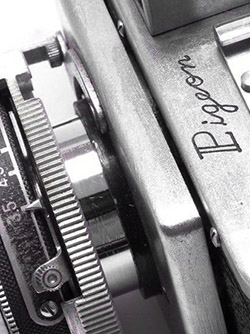 (Detail from larger web image)
(Detail from larger web image)
Pigeon 35 Model P
Sugiyama shows a camera of very similar appearance to the first type in regards to top plate, viewfinder and knobs with half-height knurling. Not surprisingly, it is also claimed to be from 1951. He calls it a “Pigeon P”. It has the same 50 mm “SHINANO COHOTO” f/3.5 lens of the second example above. However, the Tubasa shutter is lower spec with Time, Bulb and speeds limited to 1/25 to 1/150 speeds. Focusing is by front lens element (similar to the front ring rotation of the Model I but only the front element moves, not the whole assembly) so the lens/shutter assembly is very similar to the later J models.
It may precede the Model I but there is no way to know for sure. Personally, I think that it is from a very similar time, possibly a fraction later because of the Kodak ASA type flash sync (instead of 2 pin type on the Model I), and that given the low spec shutter and front element focusing, it is a budget type companion for the Model I, just as the J models seemed to be later on.
Amazingly, in the same week that I saw my first Model I for sale, the first Model P was listed as well. Unfortunately, there are some bits missing including the lens bezel and retaining ring with lens details:


(Detail from larger web images)
The shutter has the same specs as Sugiyama's P but the name is “KIKO-C”. What I understand is that “Tubasa” and “Tsubasa” are names used by camera maker Kigawa Kōgaku and that it was probably also responsible for the KIKO-C shutter.
Pigeon 35 Unknown Model (probably late I or early II)
The camera below might be a version of the Model I or it may be a different model that fits between the I and the II below or it could even be the first type Model II, but its serial number is only about 150 more than the first Model I above and 120 more than the second:
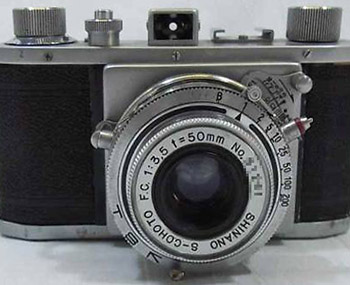 (Detail from larger web image)
(Detail from larger web image)
Like the above examples, it still has a 50 mm lens instead of the 4.5 cm of later models. The lens name is “SHINANO S-COHOTO”, note the addition of the “S-”. The TSK shutter features Bulb and 1 to 1/200 speeds. Like later examples, the winding and rewinding knobs now have full-height knurling. It is the first example with lever focus. This is at the back of the lens assembly and incorporates a depth of field scale. Like the Model I, the whole lens/shutter assembly moves in and out. Like the Model P, the flash sync is an ASA shutter mounted type.
Another two examples have also surfaced. The second one also has similar features and a serial number about 95 higher than the first, however, the lens serial number of the first one is 5 digit 812xx, the lens serial number of the second is 3 digit 19x. It may have been fiddled with in Photoshop (doesn't appear to have been) but that is unlikely as the camera serial number is clearly displayed.
The third example has the highest body number and reverts to a 5 digit lens number, 815xx.
Pigeon 35 Model II
The Endō Camera Stores ad below from a 1952 Asahi Camera magazine features accessories including lens hoods and filters, the 4.5 x 6 Semi Frank folding camera mentioned by Camera-wiki (released in 1951 according to both Camera-wiki and Sugiyama) and two Pigeon 35 models, the Model II, or “II type” pictured and “Junior type”. The Junior still has a 50 mm lens but the shutter is Bulb and 1/10 to 1/200 so an advance on the Model P but still in the budget range. The Model II is somewhat similar to the previous camera (Unknown Model) but has a 45 mm Tri-Lausar lens already even though it still features the earlier 2 pin flash sync. As such, it doesn't do anything to clear up where the previous camera belongs.
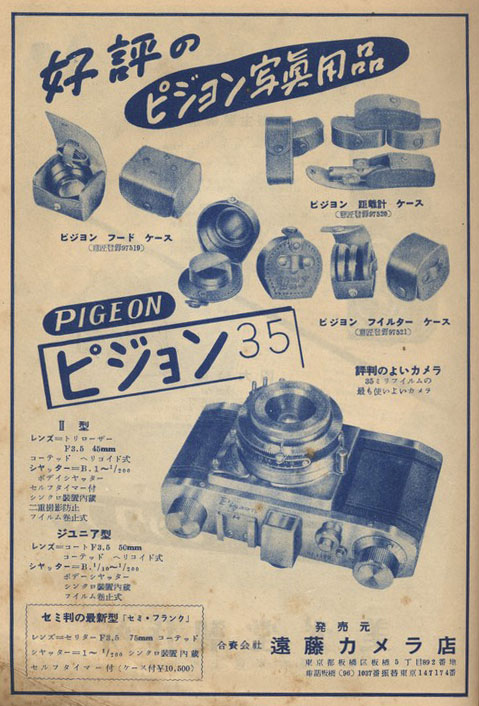
(Ad is from a Japanese website featuring manuals and other downloadable material)
Both Manfred Schmidt Collectible Cameras and Accessories and Cameras Downunder list a “Model IIA” which matches the example below. Because Sugiyama, who is sometimes wrong but more often right, calls the next version “Model IIA”, I think that this is still a “Model II”.
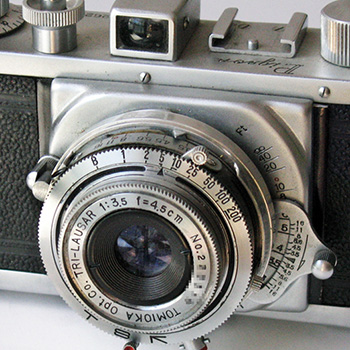 (Detail from larger web image)
(Detail from larger web image)
As far as I can tell, the top plate is the same as the cameras above including the external mounting screws and the shutter button. The lens board or mounting plate is the more sculpted style of later cameras but that is a minor change. The shutter is a TSK with Bulb and speeds from 1 to 1/200. The lens is a f/3.5 4.5 cm TOMIOKA Opt. Co. TRI-LAUSAR with flash sync and self-timer.
Pigeon 35 Model IIA
I'm calling this lovely example below “IIA” because it is a bit later and matches Sugiyama's IIA from 1952:
(Images courtesy of Chris Whelan)
(Click on images for larger version)
There are two other examples in my database with similar, but slightly lower, serial numbers.
The main difference to the II is the larger viewfinder housing. The shutter is a NKS with Bulb and speeds from 1 to 1/200. The lens is a f/3.5 4.5 cm TOMIOKA Opt. Co. TRI-LAUSAR with flash sync still on the shutter (just under the “S” of NKS) and self-timer.
On the left is the same camera with lens hood marked “Pigeon 36” and filters that fit inside the hood, on the right a hood marked “Pigeon 35” (both come with adaptors) and more likely to be specifically for the Pigeon 35 camera (more on lens hoods here):
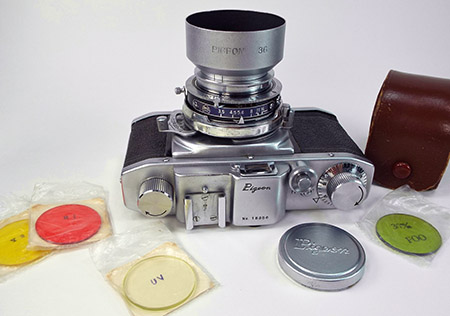
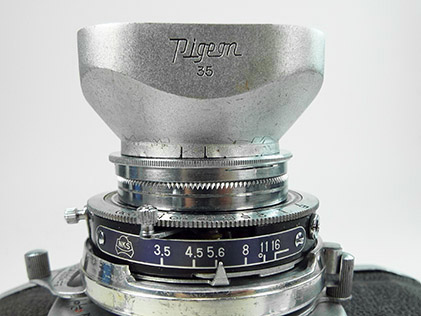
(Images courtesy of Chris Whelan)
Pigeon 35 Model IIB
I'm calling this one below “IIB” because it is a bit later still. Instead of the shutter button on the top plate (for which Shinano used an external link to facilitate the in/out movement of the shutter), it is a lever on the left side (looking at the camera) of the lens mount and the top plate mounting screws are now hidden:
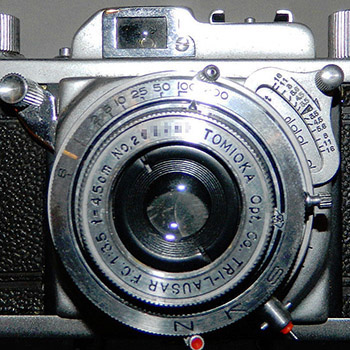 (Detail from larger web image)
(Detail from larger web image)
Pigeon 35 Model III, IIIB & IIIC
The Model III is easy to identify, it has a new streamlined viewfinder housing covering the full width of the top plate with “Model - III” engraved near the accessory shoe (it and the Model S are the only Pigeon 35 versions with the model names marked on them):
 (Image courtesy of Chris Whelan, more below)
(Image courtesy of Chris Whelan, more below)
There are three versions of the Model III (all engraved the same), confirmed by Sugiyama. He lists the first two from 1952 and the IIIC from1954. 1952 may be a little early, the ad below featuring the first version appeared in Asahi Camera in 1953 (March according to Camera-wiki.org):
.jpg) (Ad is from a Japanese website featuring manuals and other downloadable material)
(Ad is from a Japanese website featuring manuals and other downloadable material)
(Click on ad for larger version)
The first version looks like a typical knob wind camera but it's Shinano's first, and one of Japan's earliest, lever wind cameras. However, like earlier models, shutter cocking remains separate on the shutter itself. Contributor Chris Whelan's example:
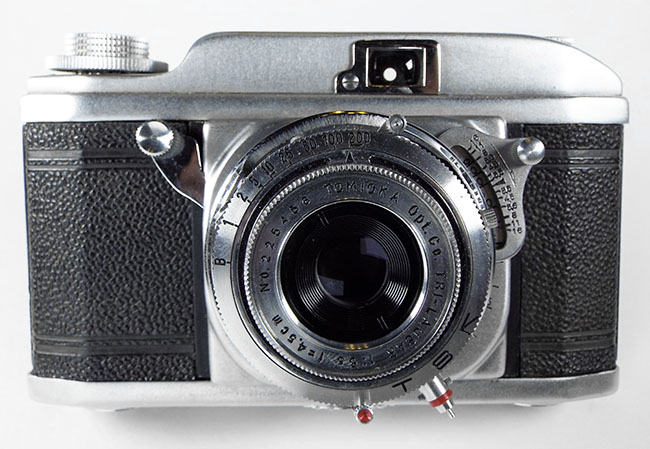
(Images courtesy of Chris Whelan)
The top knob is a film type reminder and the one underneath is the frame counter. The advance lever operates through a slot like found on the later Nicca III-L and Yashica YF:
(Images courtesy of Chris Whelan)
I can't confirm who actually invented the lever advance but the German Exakta SLRs featured a left hand operated version in the 1930s, the 1953 Leica M3 certainly popularised it and some credit the Nikon S2 released in December 1954 as the first Japanese camera to feature it, although it seems that it may have been beaten by the 1949 Minolta Memo leaf shutter camera with a bottom mounted version, if that counts. Except for the Memo, these were more advanced cameras and the lever wind cocked the shutters too (including on the Memo) but nevertheless, Shinano had not only seen the future, for a moment, it was amongst the leaders.
It has the focusing lever, shutter release and flash sync from the model IIC above together with a full range off shutter speeds from Bulb and 1 to 1/200 and self-timer. Lenses on found examples are “TOMIOKA Opt. Co. TRI-LAUSAR” and the shutters TSK.
The second version changes the film advance to a black, more familiar surface mounted lever:
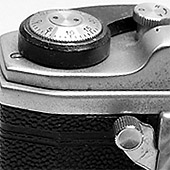 (Detail from larger web image)
(Detail from larger web image)
This was possibly called the “Model IIIB” but be warned, I have not seen that nomenclature used elsewhere, I'm using it for convenience. The lenses are still mainly “TOMIOKA Opt. Co. TRI-LAUSAR” (except for the example below). Shutters are mainly TSK except for two mid-series examples with NKS. Below is correspondent Tom Chandler's Pigeon IIIB:
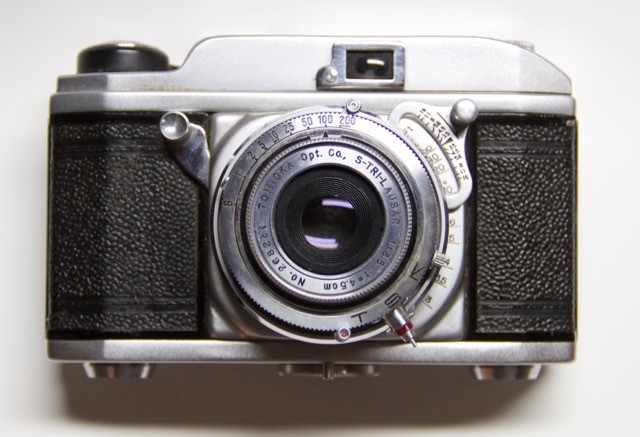
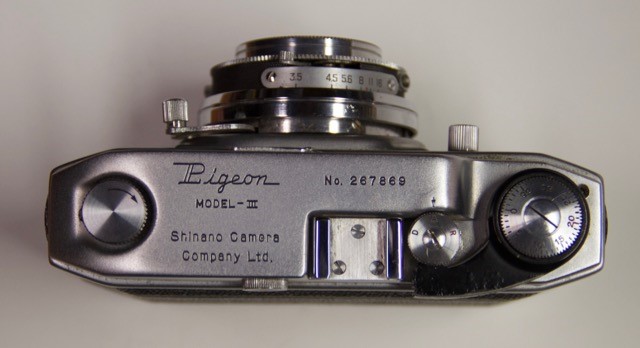
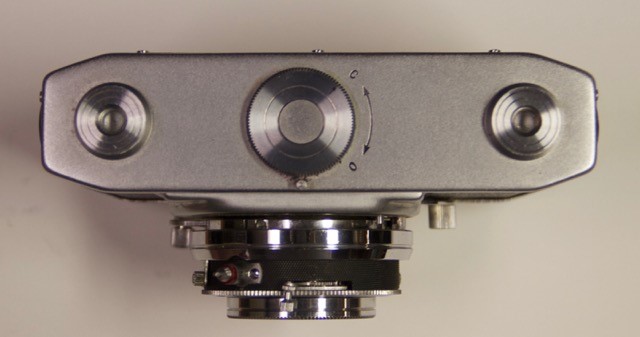 (Images courtesy of Tom Chandler)
(Images courtesy of Tom Chandler)
This is a transitional camera - it is the first example with a new back lock design found on the following IIIC examples and which is the same as featured on the Model J below.
About halfway through through its serial number range, the IIIB, including the above example, added an “S” to the lens name which became “TOMIOKA Opt. Co. S-TRI-LAUSAR” as found on all following IIIC examples. Lens numbers are not a good indicator, without the “S”, they range from 227xxx to 262xxx and with the “S”, from 230xxx to 268xxx.
The third version, “Model IIIC”, has the IIIB lever film wind but changes the lever focusing to a toothed wheel in the same place. Of six in my database, the earliest three are fitted with NKS shutters with the ASA sync now moved to the body, the fourth is fitted with an NKS-SC with the sync reverting to the lens but it is the later PC type. The fifth and sixth in my database don't appear to have shutter names, the fifth featuring a PC sync on the body and the sixth a PC sync back on the lens again. IIIC focusing wheel with body mounted ASA sync:
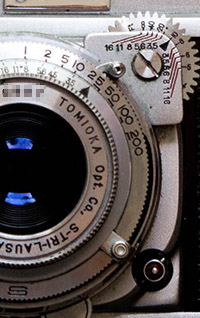 (Detail from larger web images)
(Detail from larger web images)
Below is the IIIC featured in Camera-wiki.org and scanned by Rebollo_fr from January 1955 edition of Shashin Kōgyō (the original scan includes the model IIIC name):
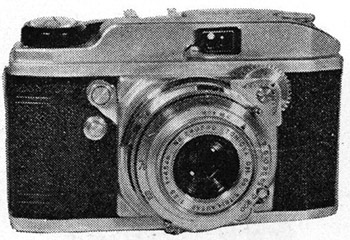 (Scanned by Rebollo_fr)
(Scanned by Rebollo_fr)
Below left is a 4 page instruction leaflet that came with Chris Whelan's model III featured further above (mainly in English except for front page) and on the right, a translation of the front page:
(Click on left cover for PDF of instructions, click on translation for larger view)
(Scans provided courtesy of Chris Whelan, cleaned up front page and translation provided by reader of Chris' yashicasailorboy.com site, “Bambi”)
Pigeon 35 Unknown Model (Model J-like)
This seems to be a cross between the II models and the following Model J. It has a body with viewfinder housing and shutter release like the Model IIB but has the front element focusing, S-Lausar lens and NKS shutter without slow speeds or self-timer like the Model J with body and lens numbers also similar to the middle of J production. One difference to both the J models is that flash sync is on the shutter rather than on the lens mount.
I've found two examples and correspondent Randy Leist has provided details of his example (below) and one other, making a total of four with serial numbers ranging from 2845x to 2872x, a tight group between the last of the IIBs with serial number 2841x and the first of the Js, 2889x:
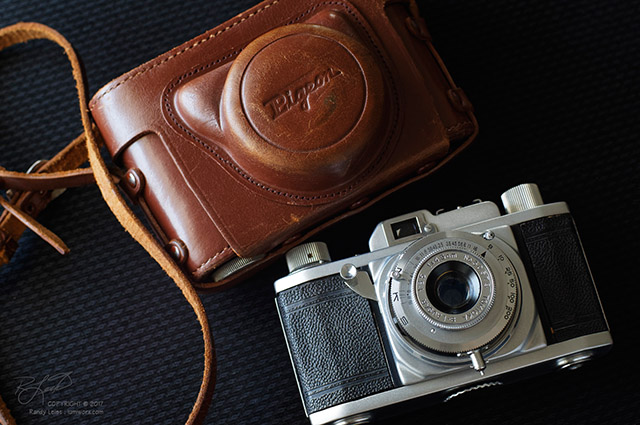 (Image courtesy of Randy Leist)
(Image courtesy of Randy Leist)
As both the J and this model share lens and shutter types and front element focusing, they seem much closer to each other than the images first suggest. To me, it looks like a pre-J model. Using the basic Model J design parameters but still featuring the Model II body before developing a unique to J style. It could be an early form of J or it could have its own name. Or it could just be another niche model sitting in between the II varieties and the J:
(Images courtesy of Randy Leist)
(Click on images for larger version)
Note that the back lock is still the earlier first type which precedes the III and J models. Also, on early II models and the J models, the film sprocket shaft is not covered (late II models and III models are unknown, none visible, all Lacons are like this but with the later lock).
Pigeon 35 Model J and JII
Below is an item from the April 1954 first edition of “Orient Photography” (also featured on the Pigeon Loft page). The photo is of what is probably the most common type Pigeon 35 and appears to be the same version as appears with the Yashima Pigeonflex in the Japanese ad. Both name it as the “model J”:
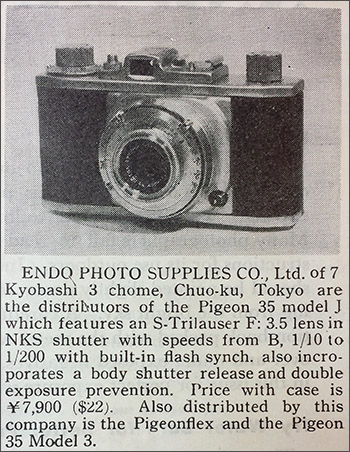 (Scan courtesy of Chris Whelan)
(Scan courtesy of Chris Whelan)
Note, the lens name is given as “S-Trilauser” but I think that should be “S-Lausar” (the Tomioka lenses featured on all found Model J examples are “S-Lausar”).
This reverts to front element focusing like the earlier Model P and the familiar shutter release button on the top plate but has a new viewfinder housing with platform for the accessory shoe and the external screws have disappeared from around the top plate, certainly making it a little later than the first of the Model II types. Like the Model P and the unknown type directly above, the Model J seems to be a budget version, losing the self-timer and slow shutter speeds. These are now limited to Bulb and 1/10 to 1/200. It was available at the same time as the Model III and like the last version of that, the IIIC, it has the flash sync in the body instead of on the lens as with earlier models and also a new look back lock on the base plate:
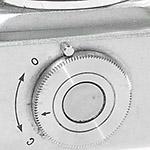 (Detail from larger web image)
(Detail from larger web image)
However, whereas late IIIC examples have a PC flash socket, I have not found any J or later JII examples so equipped.
Generally, these details suggest that the J and III models are of a similar vintage, confirmed by Sugiyama as 1954. The flash sync suggests that the IIIC may have outlasted the two Js but probably, they were intended as budget companions to the Model IIIC.
A flyer for the later JII model:
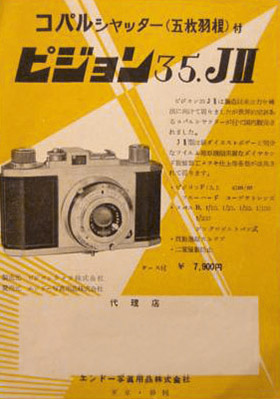 (Detail from larger web image)
(Detail from larger web image)
There are 41 examples of the J and 23 examples of the JII in my database. The J is on the left below and the JII is on the right (both are missing their mushroom type shutter button collars as is very common with the Pigeons):
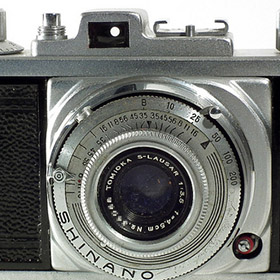

(Detail from larger web images)
Cosmetically, the differences are that the camera on the left has leatherette with lines embossed top and bottom and “Pigeon” embossed on the back like other models and the lens board is two tiered, or “sculpted” as I described it earlier, whereas the camera on the right has plain leatherette with only “Made in Japan” embossed on the back and a plain, flat lens board. Note, whilst the flat lens board trim seems to share the style with the first Model I, both Js are from much later with both featuring the new flash sync in the body instead of on the lens - the flat trim and plain leatherette are probably aimed at a more modern appearance and/or cost saving.
The model J has higher body serial numbers but the lens numbers of the JII are higher (although as noted below, the branding is different) so each model seems to have its own number series.
Whilst there are different lenses and shutters used, the specs are identical across both types. The lenses are the usual f/3.5 4.5 cm and the J continues with Tomioka as a supplier with the lenses now branded “Tomioka S-Lausar”. The first three, or possibly all four, of four JIIs in my database, with body serial numbers 1062x to 1192x, still feature the S-Lausar lens but the JII with a jump to serial number 1458x introduces “Pigeon” branded lenses.
At first glance, it seems possible that the S-Lausar is related to the Tomioka four element Tessar type “Lausar” range but as the better specified Model II and Model III examples feature Tri-Lausar triplets, and the Model III costs almost twice as much as the Model J (comparison in the two ads featured here), it seems completely improbable that the S-Lausar, or the Pigeon, would be superior. The Google translation of a partial tear-down by a Japanese blogger suggests that the S-Lausar is indeed a triplet.
The J features NKS shutters up to body serial number 3999x (about the first 66% of the database) and “Shinano” shutters after that (one NKS exception near the end); the JII features a mix of PCK and Copal shutters in the beginning, all PCK in the middle (about 50% of examples) and the last last examples (about 25% of the database) are with Copal. All are without slow speeds or self-timer.
Pictured below is correspondent Timothy Campbell's Model J complete with 34 mm push-on lens hood and “Pigeon” branded self-timer:
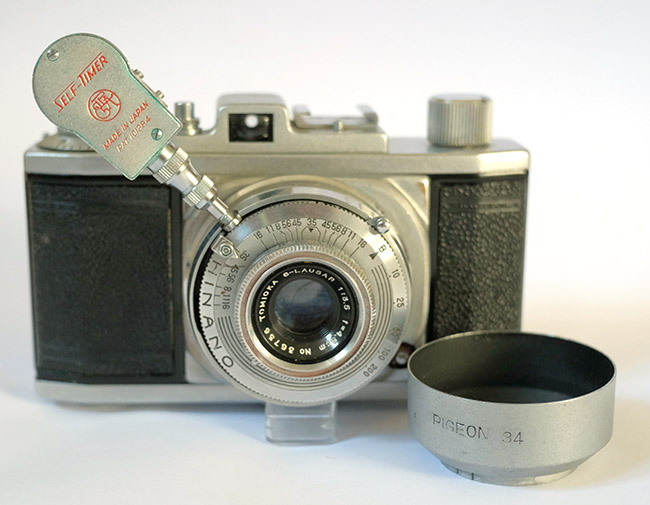
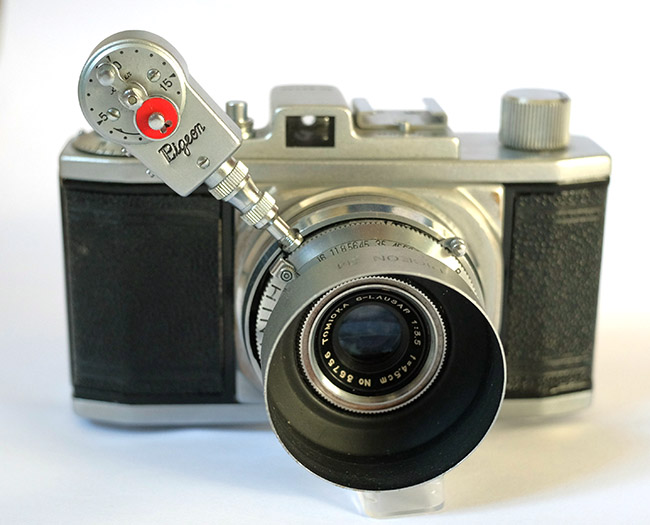
There is a Pigeon logo embossed in the leatherette on the back (hard to see in this photo):
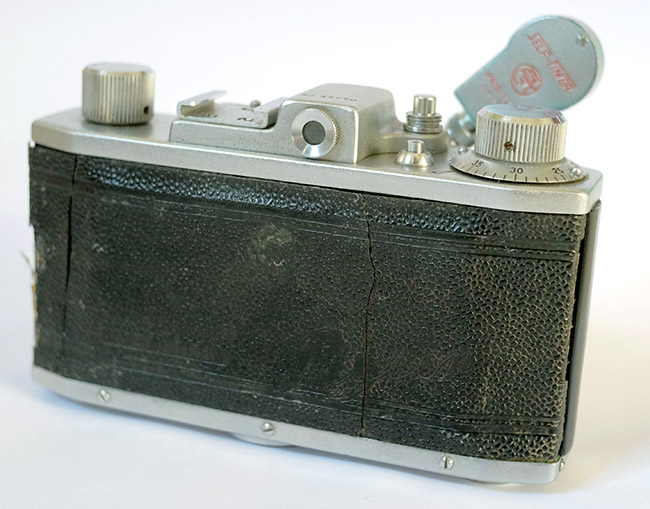
(Above images courtesy of Timothy Campbell - PCCGB.net)
Accessory self-timers mount in the the camera's cable release socket/s. Leaf shutters often have a built-in cable release socket, as found on Pigeon 35 models, but the Pigeon models also have a Leica type shutter collar which can be removed and replaced by a “Leica nipple”, the alternative mounting shown below right (an ad for Pigeon branded photographic accessories shows the self-timer with cable release collar):
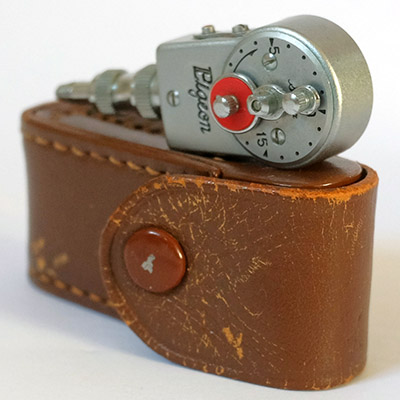
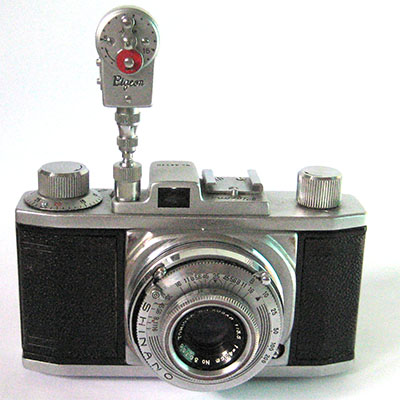
(Above images courtesy of Timothy Campbell - PCCGB.net)
In post-War Japan, two main companies produced the majority of accessory self-timers under their own names, camera company names and many distributor's names. The first Pigeon self-timer (which I have not seen) is claimed by the German Autoknips site to be made by Kobayashi Seiki Seisakusho (Kobayashi Precision Works), maker of Kobal, later named Kopil, self-timers. The one above is the later fairly easily found type which the Autoknips site claims was actually made by Shinano itself and quotes design “DSG. 101384”. The site also says that “Micronta” and “Votar” named versions are known. These are similar but there are small differences too. The Votar has “PAT 101384” on the back whilst the Micronta shares its name with the Micronta 35 camera sold by Cosmo Camera Seisakusho which seems to have inherited the Pigeon 35 body from Shinano, or perhaps Shinano was absorbed, see Cosmo 35, Micronta 35 & Rolex 35 Cameras further below.
Pictured below is contributor Sandu Baciu's JII:
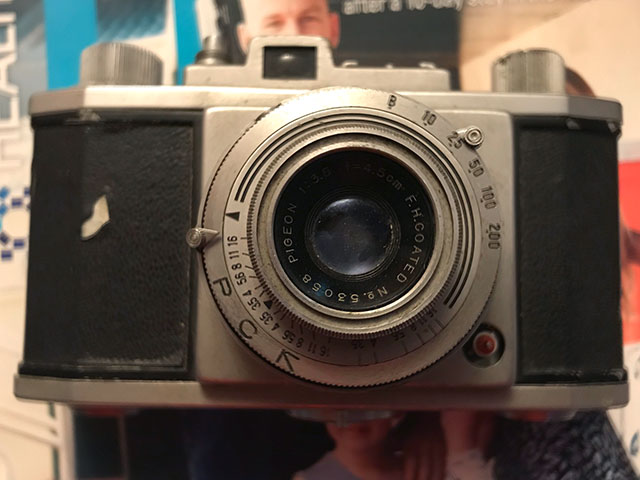
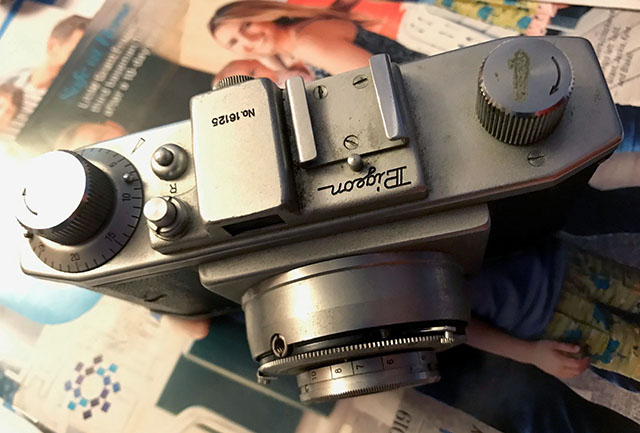
(Images courtesy of Sandu Baciu)
Pigeon 35 Model S
The Model S is rare. It's existence was first identified by correspondent Randy Leist when he found the combined manual below for sale with a Pigeon 35 Model J:
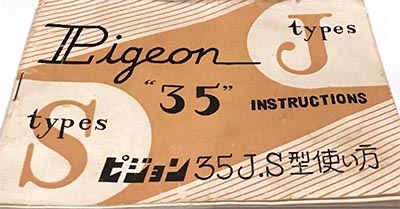 (Detail from larger web image)
(Detail from larger web image)
The fact that the J and S share a manual (there is also a discrete manual type for the Model J) is a significant clue. I have since found one that has sold in Japan. Like the III models, its name is on the viewfinder housing making it easy to identify. Amazingly, it has a budget type JII body complete with the same shutter type with limited speeds and front element focusing lens but it features a rangefinder plonked on top in a pseudo-Leica style viewfinder housing. This is almost certainly not coupled to the focusing. The distance is read off the dial at the back and transferred to the distance scale on the front. As such it is more of a focusing aid than a focusing method (note, there is no connection to the later Tougodo made Pigeon V and 5B models):


(Details from larger web images)
The viewfinder housing appears to be a stretched version of the middle Lacon type below. Whereas the shutter button end is identical, the Model S housing sits closer to the rewind knob even though the shape is the same. Also, on this camera at least, the film winding knob has knurling typical of the J models and earlier Pigeon 35s but the rewind knob has knurling typical of the middle Lacon (both knobs are shorter because of the raised platform of the viewfinder housing).
Lacon & Saga Models
I have photos of four versions of the Lacon. Although the sculpted lens mount is from the earlier JI, overall, the features seem later than the Pigeon 35 or either of the J models. The viewfinder housings/top plates followed a similar evolution to the Pigeon 35 but they are different to the Pigeon versions. The bodies, shutter release by button, focusing by front element rotation and lens and shutter specs basically match the two Pigeon 35 J models, except that the two middle versions gain a self-timer. In other words, they are all more basic than the Pigeon 35 I, II and III models. The flash sync remains on the shutter body as for earlier Pigeon 35 models but on the other hand, all the Lacon examples and the one Saga feature PC type flash sync sockets only shared with the last of the Pigeon IIIC models suggesting that the Lacons are more recent than the Pigeons. Similarly, all four Lacon types have the newer style back lock on the base plate found on the Pigeon 35 Model IIIC and J/JII.
As far as I am aware, only the third and fourth Lacon models have an identified version name. The rangefinder version of the middle pictured example below is marked “R” next to the name (see further below) and the last type with bulbous one piece top plate incorporating the viewfinder is marked “C” (“Type C” in the user manual). The three basic body styles are shown below - note the text behind the Lacon name on the middle camera is “Shinano Camera Company Ltd.”
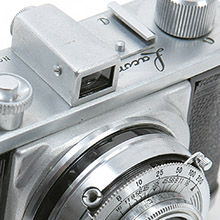
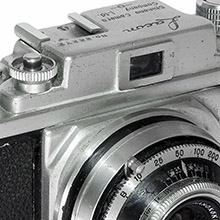
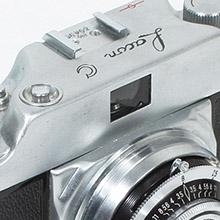
(Detail from larger web images)
This is the rangefinder version, Type R:


(Detail from larger web images)
The viewfinder/rangefinder housing is very similar to the second type except that it is extended slightly around the rewind knob in a style similar to the Leica M3 and the viewfinder is pushed right over to that side instead of the middle. With the combined viewfinder/rangefinder, it appears to be an advance on the Pigeon Model S. It is still undoubtedly not coupled with the distance being read of the dial surrounding the tiny rangefinder window. The function of the lever on the front (to set “D”) is unknown to me. The accessory shoe is the 2 screw type found on the Type C.
Three Type Cs in my database still have their presentation boxes: two are plain red brown all over with gold text and one has a blue bottom and white top, both parts with a reptile skin pattern and also gold text. The interesting thing is that both style boxes are marked “National Optical Co., Ltd.” Were the Lacons produced by Shinano for the National Optical Co. or was Shinano taken over by this company or merged with some unknown entity? A search has turned up no clues at all.
The shutter speed range of Bulb and 1/10 to 1/200 shared with the J models is updated to the more modern Bulb and 1/25 to 1/300 on the last six of the eight Type Cs in my database.
The shutters on the first three versions are branded “Shinano” and unnamed on the Type C. The lenses on the first three versions are branded “Shinanokōki Lacor” and “S-Lacor” on the Type C.
The only Saga named model I have seen is identical to the later Lacon Type C with Bulb and 1/25 to 1/300 shutter, except its top plate is engraved “Saga Three-Five”:
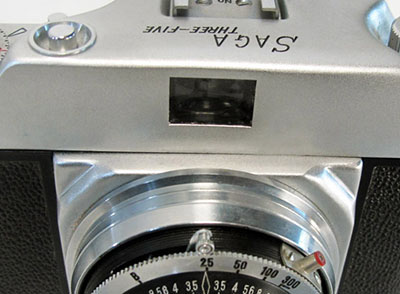 (Detail from larger web image)
(Detail from larger web image)
Focusing, Shutters & Lenses
Whether by front ring rotation/lever/dial movement of the whole lens/shutter assembly (Pigeon I, II and III variants) or by front element only movement (Pigeon P, J, JII, S, Lacon and Saga), focusing on all models is set by simple distance scale (the S has a rangefinder aid). The more up-market Pigeon I, II and III variants started with “normal” shutter buttons and an external link to the shutter but changed to a shutter lever on the lens board and internal link. The budget versions all have “normal” shutter buttons except for the unknown J-like model.
This table consolidates detail from the above discussion. Note, only some of the model names are confirmed, I have used “logical” names to fill in the gaps. These are highlighted in grey fill:
Model |
Lens |
Focal Length |
Focusing |
Shutter |
|||
Brand |
Speeds |
Self-timer |
Release |
||||
| Pigeon 35 | |||||||
I |
Shinano Cohoto |
50 mm |
Front ring |
NKS |
B, 1-1/200 |
Yes |
Button |
P |
Shinano Cohoto |
50 mm |
Front element |
Tubasa |
B, 1/25-1/150 |
Yes |
Button |
P |
? |
? |
? |
Kiko-C |
B, 1/25-1/150 |
? |
Button |
? |
Shinano S-Cohoto |
50 mm |
Lever |
TSK |
B, 1-1/200 |
Yes |
Button |
II |
Tri-Lausar |
4.5 cm |
Lever |
TSK |
B, 1-1/200 |
Yes |
Button |
IIA |
Tri-Lausar |
4.5 cm |
Lever |
NKS |
B, 1-1/200 |
Yes |
Button |
IIB |
Tri-Lausar |
4.5 cm |
Lever |
NKS |
B, 1-1/200 |
Yes |
Lever |
III |
Tri-Lausar |
4.5 cm |
Lever |
TSK |
B, 1-1/200 |
Yes |
Lever |
IIIB |
Tri-Lausar |
4.5 cm |
Lever |
TSK |
B, 1-1/200 |
Yes |
Lever |
IIIB |
Tri-Lausar |
4.5 cm |
Lever |
NKS |
B, 1-1/200 |
Yes |
Lever |
IIIB |
S-Tri-Lausar |
4.5 cm |
Lever |
TSK |
B, 1-1/200 |
Yes |
Lever |
IIIB |
S-Tri-Lausar |
4.5 cm |
Lever |
NKS |
B, 1-1/200 |
Yes |
Lever |
IIIC |
S-Tri-Lausar |
4.5 cm |
Lever |
NKS |
B, 1-1/200 |
Yes |
Lever |
IIIC |
S-Tri-Lausar |
4.5 cm |
Lever |
NKS-SC |
B, 1-1/200 |
Yes |
Lever |
IIIC |
S-Tri-Lausar |
4.5 cm |
Lever |
Unbranded |
B, 1-1/200 |
Yes |
Lever |
? |
S-Lausar |
4.5 cm |
Front element |
NKS |
B, 1/10-1/200 |
No |
Lever |
J |
S-Lausar |
4.5 cm |
Front element |
NKS |
B, 1/10-1/200 |
No |
Button |
J |
S-Lausar |
4.5 cm |
Front element |
Shinano |
B, 1/10-1/200 |
No |
Button |
JII |
S-Lausar |
4.5 cm |
Front element |
PCK |
B, 1/10-1/200 |
No |
Button |
JII |
Pigeon |
4.5 cm |
Front element |
PCK |
B, 1/10-1/200 |
No |
Button |
JII |
Pigeon |
4.5 cm |
Front element |
Copal |
B, 1/10-1/200 |
No |
Button |
S |
Pigeon |
4.5 cm |
Front element |
Copal |
B, 1/10-1/200 |
No |
Button |
| Lacon | |||||||
A |
Shinanokōki Lacor |
45 mm |
Front element |
Shinano |
B, 1/10-1/200 |
No |
Button |
B |
Shinanokōki Lacor |
45 mm |
Front element |
Shinano |
B, 1/10-1/200 |
Yes |
Button |
R |
Shinanokōki Lacor |
45 mm |
Front element
|
Shinano |
B, 1/10-1/200 |
Yes |
Button |
C |
S-Lacor |
45 mm |
Front element |
Unbranded |
B, 1/10-1/200 |
No |
Button |
C |
S-Lacor |
45 mm |
Front element |
Unbranded |
B, 1/25-1/300 |
No |
Button |
| Saga | |||||||
Three Five |
S-Lacor |
45 mm |
Front element |
Unbranded |
B, 1/25-1/300 |
No |
Button |
Camera-wiki.org notes the availability of NKS, PCK and TKS shutters on the Pigeon 35. I haven't found any with the TKS yet (made by Tōsei Kōki, different to the TSK made by Tōyō Seiki Kōgaku - I think that “TKS” is a mistake, McKeown lists TSK) but from photos of examples on the net, I can add Copal and Shinano, the latter which I assume is simply re-branding and of course, TSK. The Model P identified by Sugiyama has a Tubasa shutter with limited 1/25-1/150 speeds and another example has a similar spec Kiko-C probably made by the same company.
Lenses on the Models I and P are f/3.5 50 mm, branded “SHINANO COHOTO” and on the unknown model, “SHINANO S-COHOTO”. All other lenses are f/3.5 4.5 cm on the Pigeons, marked 45 mm on the Lacons. The lenses on the higher spec and price Models II and III are triplets branded “TOMIOKA Opt. Co. TRI-LAUSAR” (“TOMIOKA Opt. Co. S-TRI-LAUSAR” on the IIIC model), therefore the “TOMIOKA S-LAUSAR”, is also almost certainly a triplet not related to Tomioka's Tessar type “Lausar”. That no doubt also applies to “PIGEON” and varieties of “LACOR” branded lenses. Note that triplet lenses, whilst quite acceptable for mass-market TLRs, are a poorer choice for 35 mm where their lack of sharpness in the corners and aberrations are magnified.
Body Castings
All the bodies seem to be based on a similar design concept but there were some changes along the way. Image 1 is the inside view of what I have earlier called a Pigeon 35 Model IIA. It is very similar to the earlier Models I and P. The front casting is separate to parts of the transport assembly, note the alloy hook for the earlier type back lock knob shown in the IIA pictures further above (the I and P use the same hook but the lock is slightly different). The camera in image 2 is a Pigeon 35 Model JII. It has a one piece casting for the body and film transport. The Lacon Type B (perhaps, or at least, 2nd type found) in image 3 is very similar except the shaft of the sprocket drive is enclosed. What is believed to be the Pigeon 35 unknown model (cross between a Model II and J) also has the covered shaft and adds the black painted guides of the camera in image 4. The Lacon Type C in image 4 has a modified casting with more angular film chamber. Note that the cameras in images 2, 3 and 4 share the same type back lock internal catch plate and also the locking knob as shown for the Model J above and also below:
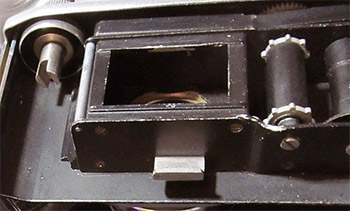
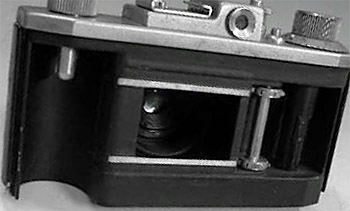
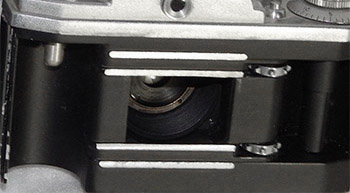
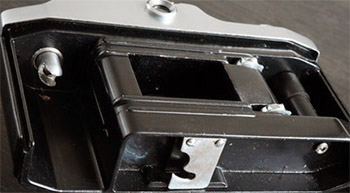
(Detail from larger web images)
Cosmo 35, Micronta 35 & Rolex 35 Cameras
This is a postscript but a very important one in connection with the TLR genealogy. According to Camera-wiki.org, Cosmo Camera Seisakusho was the Japanese successor company to both Tōyō Seiki Kōgaku, maker of the TSK shutter, and Alfa Optical Co. which made Alfaflex and Cosmoflex TLRs (and very probably, Pigeonflex I, IB and IC models). Camera-wiki.org notes that the Cosmo Camera Seisakusho made Cosmo 35, Micronta 35 and Rolex 35 “body casting and removable back are copied on the Pigeon 35”. I'm not entirely sure what is meant by that statement but the Pigeon 35 is the earlier camera by several years, the Cosmo 35 being announced in September 1955. Certainly, the body castings and backs, outside and inside, appear to be near identical. The top plate and viewfinder housings are clearly different to the Shinano cameras but the octagonal bodies, the flat lens boards, shutter housings and front lever shutter release are very similar to, or at least look like evolved elements of, the Pigeon 35 II, III and J and Lacon models.
Below are photos of the same Cosmo 35 example - apart from the unmachined film guides, the castings and lock plate appear to be identical to the Model J above and similar to all the others:
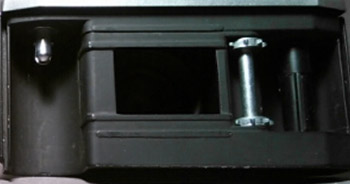

(Detail from larger web images)
Below left is the central lock knob for the Cosmo 35 back and on the right, the lock from a Pigeon 35 J (the Pigeon 35 IIIC and Lacon models are the same, the earlier Pigeon 35 II & III models operate the same way but the locks are quite different):

 (Detail from larger web images)
(Detail from larger web images)
The Alfa Optical Co. link to the Cosmo 35 is strengthened by the lens name, “S. Cosmo”, as used on all its Alfaflex and Cosmoflex TLRs. Clearly at some point, there must have been a relationship of some sort with Shinano.
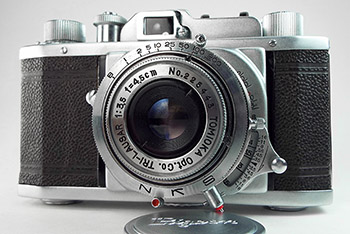
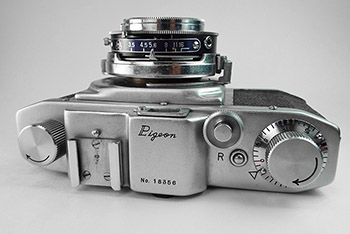
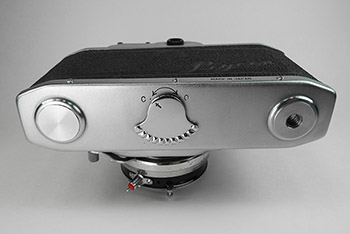
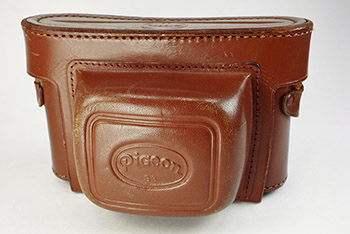
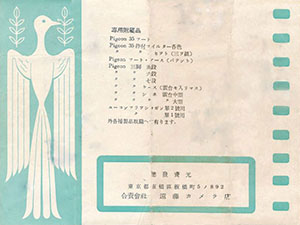
.jpg)
